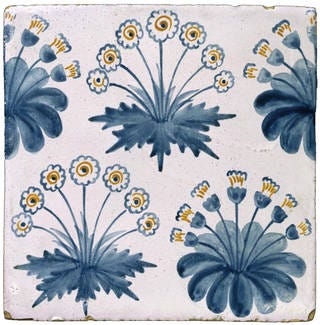Working On: creating meaningful work through art + design
or, the politics of the Arts & Crafts Movement
I was meant to be writing about something else this week, but I’ve just finished reading Peacock & Vine by A.S. Byatt, which is a dual portrait of the designers William Morris and Mariano Fortuny. Byatt compares and contrasts the two men, reflecting on their motivations, tastes, politics, and resulting works, highlighting their similarities and differences. There is a wonderful chapter about pomegranates.

Fortuny is very interesting - and I may come back to him later - but it was Morris who really captivated me, and therefore I’ve become deeply enraptured by the Arts & Crafts Movement. (William Morris was not the founder of the movement, but became deeply involved in it and, at this point, I would say he’s the most famous artist to have been part of it.)
I’ve always loved Morris & Co. designs, especially their textiles, but reading extended quotes from Morris on his philosophy of design and artistic goals adds a new dimension. Many people know his famous quote, “Have nothing in your houses that you do not know to be useful or believe to be beautiful”, but I hadn’t really appreciated until now how crucial utility really was to the Arts & Crafts ethos. In fact, one of the guiding principles of the Movement was that the work itself, the act of creation, was of utmost importance.

William Morris was a socialist who believed in the value of good work. Growing up amidst the Industrial Revolution, he abhorred factory labor, feeling that by breaking up the manufacturing process into repetitive chunks, efficiency was gained but something essential to the human spirit was lost. He believed that high-quality craftsmanship was the ultimate goal; that true ownership and enjoyment of one’s work could only be achieved if design and manufacture were undertaken by the same person, who would be fully engaged in the creative process. His commitment to this ideal led him to learn embroidery, plant dyeing, printmaking and many other crafts - he wanted not only to design, but to make.

To William Morris, art was deeply enmeshed in everyday life - and it was political. The Arts & Crafts Movement was an artistic style, certainly, but it was just as much a social ethos. It was wide-ranging, and encompassed architecture, surface design, textiles, furniture, fashion, jewelry, ceramics, metalwork and more. Morris wrote and delivered lectures on both design and politics, and was a committed environmentalist. In 1891, he established Kelmscott Press, producing books that were designed and made in a medieval style, with stunning illustrations.

As a design style, Arts & Crafts was tremendously successful, becoming the dominant style of interior decoration by the end of the 19th century, and Morris & Co. fabrics and prints are still extremely popular today. But it’s the overall philosophy of the Movement - their idealism, perhaps - that I find myself most impressed by. As a craftsperson myself, I share the Arts & Crafts dedication to (and love of) handcraft and their emphasis on everyday art. I think the objects we use should be both well-made and as beautiful as they can be, and I believe that we should consciously work toward this ideal.
These concepts are also similar to the philosophy of life and art that can be found at Charleston Farmhouse (which is interesting, considering that Vanessa Bell and Duncan Grant were part of Omega Workshops, an interior design group that would have been a direct competitor of Morris & Co.). My feeling is that these ideals are really about valuing life, creativity, and work, and combining them to create a kind of everyday magic. It’s aspirational, but also, I think, achievable - which is what I find so compelling.
All of Morris’ designs are enchanting, but it is definitely the embroideries that I find myself especially drawn to.

In 1885, Morris’ daughter May took charge of his embroidery workshop, and I suspect that a good amount of the work that I so admire from Morris & Co. was hers. She was a fascinating, talented woman and I’ll be writing more about her soon.
In the meantime, I’m drawing inspiration from Morris embroideries for my own work. I’ve been stitching a sort of sampler on and off for a weeks now, and have very nearly finished it. The design is my own, and I’ve had an unbelievable amount of fun working on this project - it’s part of a little foray I’m making into a more visual fiber arts practice, and I’m really excited by this new direction. I’m not sure where this will lead me, but I have plenty of ideas, so I’m just going to follow my inspiration and see what happens.
Well, that’s it from me this week! If you enjoyed this newsletter, please feel free to forward this email to a friend or share on social media. I’ll be back next week with more thoughts on art, creativity, and textiles. Talk to you soon!





Beautiful embroidery Kelsey! I've come across William Morris' textiles before somewhere and they are magnificent.
I look forward to seeing your sampler. High quality craftmanship is my goal in sewing. And you have me wondering if I can take up embroidery.